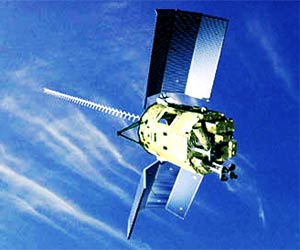Stars and STEM Stories
GLOBE Argentina Video Conference: Pondering Earth and Space

GLOBE students and teachers linked up with scientists and astronauts from Argentina and the United States at a video conference in June entitled "El Espacio, La Ciencia, y el Medio Ambiente" (Space, Science and the Environment). Video and audio equipment joined four sites: Buenos Aires, San Luis and Santa Fe in Argentina, (which also hosted GLOBE students and teachers), and the Johnson Space Center in Houston, Texas, USA. Officials from Argentina's space agency, Comision Nacional de Actividades Espaciales (CONAE) joined officials from the U.S. National Aeronautics and Space Administration (NASA) in presenting topics from manned activities in space to the latest satellite projects.
Via an uplink from Houston, Costa Rican-born NASA astronaut Dr. Franklin Chang-Diaz wowed the conference with stories of his most recent trip into space and took questions from GLOBE students. Then CONAE scientists talked about a subject important to GLOBE students' mission - how satellite imagery can help us study Earth and how ground-based observations from volunteers like GLOBE students can bolster satellite information.
Dr. Marcos Machado, CONAE's Scientific Director, and Dr. Monica Rabolli, a CONAE Institutional Relations officer, discussed SAC-C, one of the most recent satellites monitoring Earth. SAC-C is a joint NASA/CONAE project that is also supported in a variety of ways by scientists in Brazil, Denmark, France and Italy. The SAC-C spacecraft is part of NASA's Earth Observing Satellites (EOS) project, designed to study the structure and dynamics of the Earth's atmosphere, ionosphere and geomagnetic field.
The SAC-C satellite's scientific mission is to
- Provide Multispec images of the Earth to monitor the condition and dynamics of the terrestrial and marine biosphere and environment;
- Develop and use new GPS-based techniques to globally measure atmospheric phenomena for the study of weather, seasonal, inter-annual and long term climate change;
- Enhance the understanding of the Earth's magnetic field and related Sun-Earth interactions;
- Measure high-energy radiation in the environment, trapped particle intensities and energy distribution and the influence on advanced electronic components; and,
- Help determine the migration route of the Franca whale.
In the province of Santa Fe, the conference was broadcast live to televisions in schools and homes. By popular demand, Canal Familiar TV, the cable system that participated from Santa Fe, re-broadcast it that evening and the following week.
"It was very exciting for the students because they could make their own questions and their fellow students could follow the discussion [from home or school]," said Luciano Zocola, director of Canal Familiar TV. "In addition to the positive effect on the participants, we have also noticed ... other students, teachers and parents, who became very enthusiastic about knowing more about the GLOBE Program and other science projects."
Marshall Carter-Tripp, U.S. Embassy Science and Environment Counselor in Buenos Aires, was also impressed with the level of interest and understanding of the GLOBE students. She noted that their questions were probing and intelligent, as they sparked discussions about the difference between satellite imagery and photography and the possibilities of seeing water pollution from space.
"We believe the GLOBE Program has clearly been effective in developing [school children's] interest in environmental protection," Carter-Tripp said.
Argentina GLOBE Country Coordinator Maria del Carmen Galloni and the GLOBE Office congratulated the students and teachers for their hard work during the videoconference and on their GLOBE studies throughout the year. For more information on GLOBE in Argentina or on this conference, please email Professor Galloni: mgalloni@uces.edu.ar
CONAE officials have invited students to participate in a short weekly course on satellite imagery.
9 December 2002





